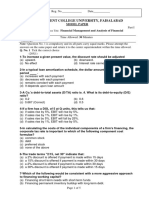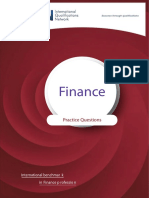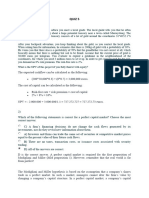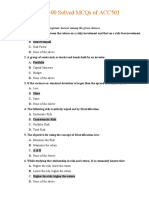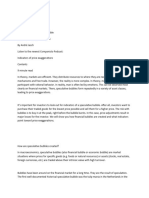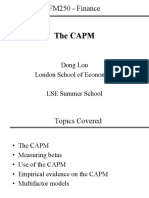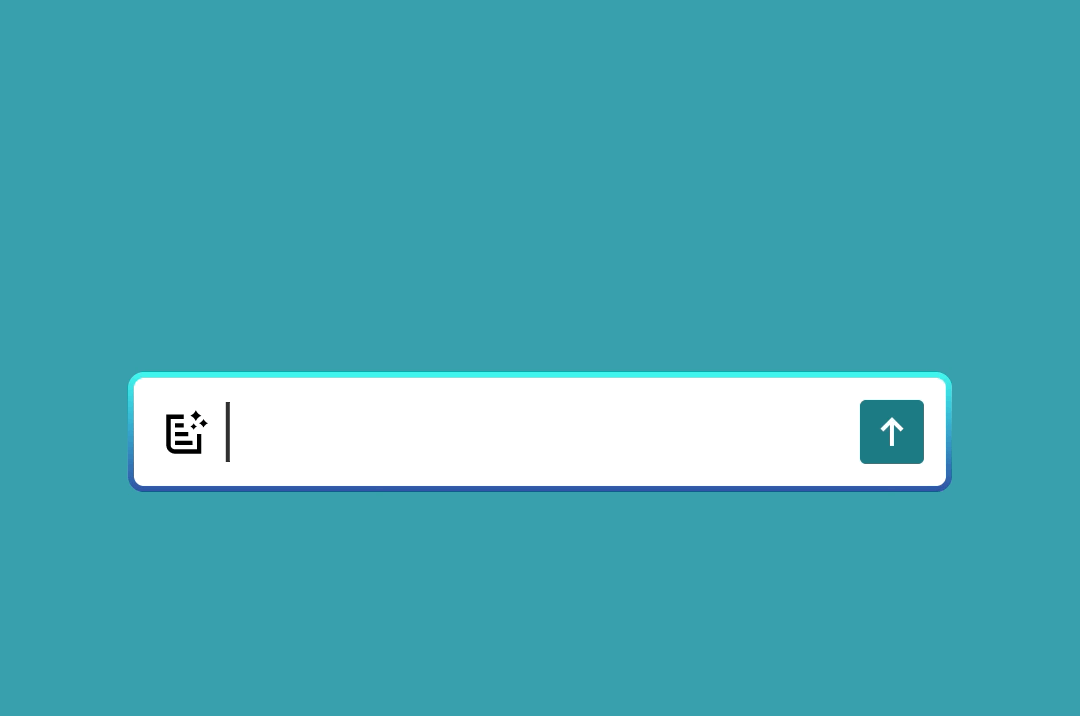Part – I: Short Answer Questions
1.
Discuss the risk – return relationship involved in the firm’s asset investmentdecisions as it pertains to working capital management.
2.
Define collection float and identify the role of each type of float.
3.
What are the five traditional “C” the financial manager might consider inevaluating the credit worthiness of a potential customer?
4.
What is the significance of economic order quantity to the financial manager?Explain.
5.
State the nature of risk on the context of finance?
6.
What is the difference between a stand-alone risk and a portfolio risk?
7.
What is financial leverage and how does it affect the risk associated with futureearnings to shareholders?
8.
If the marginal tax rate on corporate income were to increase, what do you expectto be the effect of this on the tax shield from interest deductibility?
9.
Consider three financing alternatives:Alternative A: Finance solely with equityAlternative B: Finance using 50% debt, 50% equityAlternative C: Finance solely with debta. Which of the three alternatives involves the greatest financial leverage?b. Which of the three alternatives involves the least financial leverage?
10.
Explain the nature of dividend policy.
11.
Describe what lease financing mean.
12.
List the potential costs associated with financial distress.
13.
List the potential direct and indirect costs associated with bankruptcy.
14.
What is the difference between liquidation and reorganization? Discuss briefly.
15.
What do we mean by the three – month forward exchange rate?1
Part – II: Work Out Questions
1.
Super Batteries Enterprise turns out 1,800 automobile batteries a day at a cost ofBr. 900 per battery for materials and labor. It takes the firm 20 days to convertthe raw materials into battery. The enterprise allows its customers 38 days inwhich to pay for batteries, and the firm generally pays its suppliers in 30 days.\
Required:
i) What is the length of the cash conversion cycle? ii) At a steady rate in which the firm produces 1,800 batteries a day, what amount of working capital must it finance?iii) By what amount could the firm reduce its working capital financing needs if it was able to stretch its payable deferral period to 33 days?
2.
Each business day, on average, a company writes checks totaling Br. 25,000 topay its suppliers. The usual clearing time for the checks is five days. Meanwhile,the company is receiving payments from its customers each day, in the form ofchecks, totaling Br. 42,000. The cash from the payments is available to the firmafter two days.
Required
: a) Calculate the company’s disbursement float, collection float, andnet float b) How would your answer to part (2) change if the collected funds wereavailable in one day instead of two?
3.
Sunshine Inc, has weekly credit sales of Br. 75,000, and the average collectionperiod is 40 days. The cost of production is 80 percent of the selling price. Whatis sunshine’s average account receivable figure?
4.
Shewa pottery store begins each month and reordered. If the carrying cost per potis Br. 5 per year and the fixed order cost is Br. 60, what is the total carrying cost?What is the restocking cost, and what is EOQ?
5.
Security A has an expected return of 7%, a standard deviation of expected returnsof 35%, a correlation coefficient with the market of -0.3, and a beta coefficient of-0.5. Security B has an expected return of 12 %, a standard deviation of returns of10%, a correlation with the market of 0.7, and a beta coefficient of 1.0. Whichsecurity is riskier? Why?2
6.
Suppose you owned a portfolio consisting of Br. 250,000 worth of long-termgovernment bonds.a)Would your portfolio be riskless?b)Now suppose you hold a portfolio consisting of Br. 250,000 worth of 30-dayTreasury bills. Every 30 days your bills mature, and you reinvest theprincipal (Br. 250,000) in a new batch of bills. Assume that you live on theinvestment income from your portfolio and that you want to maintain aconstant standard of living. Is your portfolio truly riskless?c)Can you think of any asset that would be completely riskless? Couldsomeone develop such an asset? Explain.
7.
Suppose
Stock
i
with k
RF
= 9%, k
M
= 14%, and b
i
= 1.3. What is k
i
, the requiredrate of return on
Stock
i
?
8.
The market and Stock J have the following probability distributions:
PROBABILITYk
M
k
J
0.315%20%0.4950.31812a)Calculate the expected rates of return for the market and Stock J.b)Calculate the standard deviations for the market and Stock J.c)Calculate the coefficients of variation for the market and Stock J.
9.
Stocks X and Y have the following probability distributions of expected futurereturns:
PROBABILITYXY
0.1(10%)(35%)0.2200.412200.220250.13845a)Calculate the expected rate of return, kˆ, for Stock Y. (kˆ
X
= 12%.)b)Calculate the standard deviation of expected returns for Stock X. (Thatfor Stock Y is 20.35 %.) Now calculate the coefficient of variation for3
Stock Y. Is it possible that most investors might regard Stock Y as beingless risky than Stock X? Explain.
10.
Consider the information on the three firms A, B, and C:
CapitalFirm AFirm BFirm C
DebtBr. 1,000Br. 2,000Br. 3,000EquityBr.3,000Br. 2,000Br. 1,000
Required:
a. Calculate the debt ratio for each firm.b. Calculate the debt-to-assets ratio for each firm.
11.
The
Che Belew Corporation
is considering three possible financing arrangementsto raise Br. 10,000 of new capital. Currently, the capital structure of
Che Belew
consists of no debt and Br. 10,000 of equity. There are 500 shares of commonstock currently outstanding, selling at Br. 20 per share. The
Che Belew
isexpected to generate Br. 12,000 of earnings before interest and taxes next period.It is expected that the interest rate on any debt would be 10%. The three possiblefinancing alternatives are:
Alternative 1: Finance completely with new equity. Alternative 2: Finance using 50% debt and 50% new equity. Alternative 3: Finance completely with new debt.
Required:
a. Calculate the following items for each alternative, assuming that there are notaxes on corporate income:■ Earnings to owners■ Earnings per share■ Distribution of income between creditors and shareholdersb. Calculate the following items for each alternative, assuming that the marginalrate of tax on corporate income is 40%:■ Earnings to owners■ Earnings per share■ Distribution of income among creditors, shareholders, and thegovernment4


































